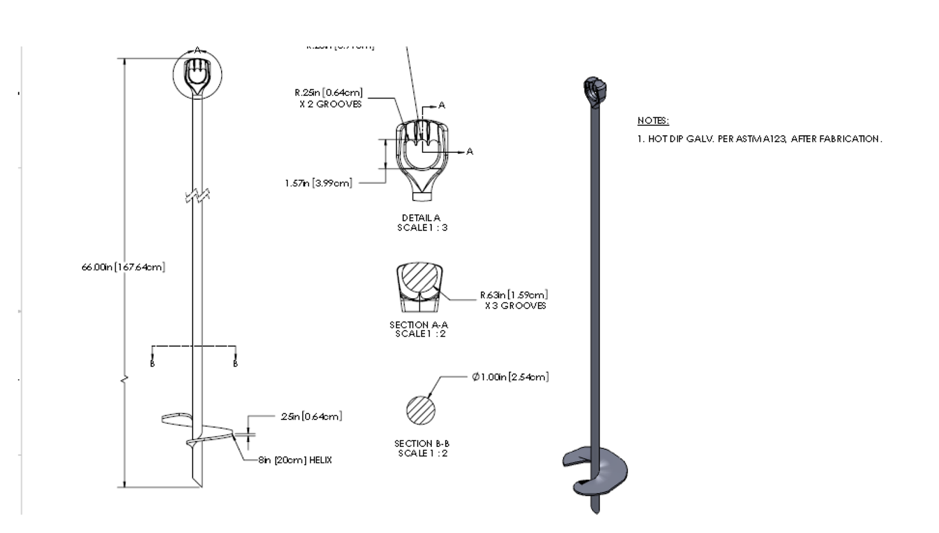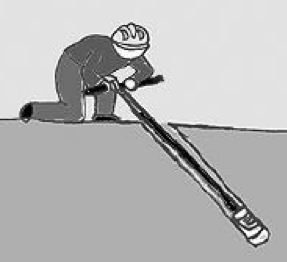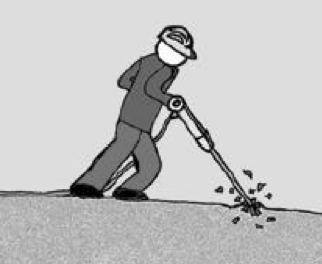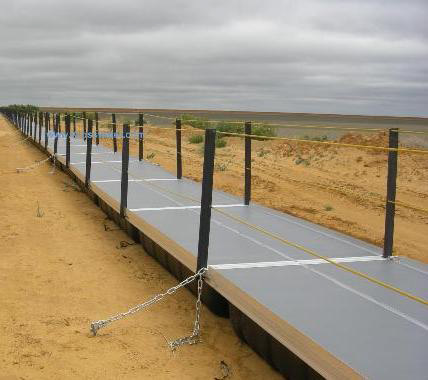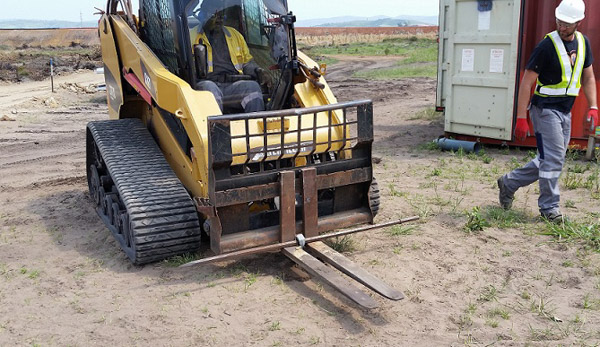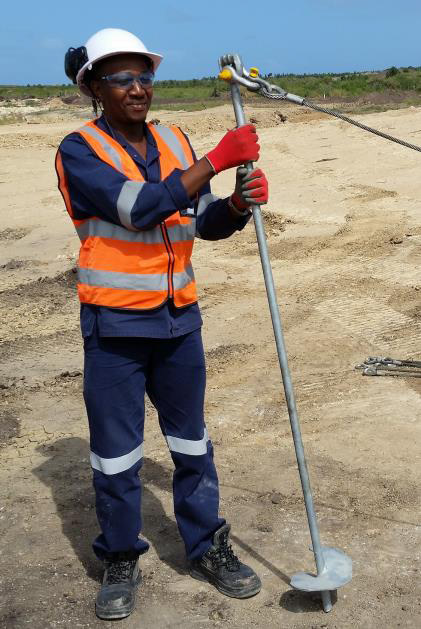Types of Anchors
Chain Web Anchors
Chain web anchors is a configuration of chains that are linked together to offer a web network that is reliant upon shared anchoring points to maintain the walkway’s position. Often used in locations with tidal movements and / or where anchoring can be difficult due to steep underwater slopes, or in water reservoirs where water level can drop and increase considerably. Such anchoring configurations can require multiple types of anchor load points and ballast not normally required on Tailings Dam
Screw-In Anchors
Screw-in anchors are recommended for softer soil types, Classes 5-7. They do not work well in rocky soils. The screw-in anchor is a hot-dip galvanized steel bar with an eye on one end for attaching the guy wires or chain and a variable diameter screw at the bottom depending upon the soil conditions. These are standard anchors used in the utility industry.
Screw-in anchors are usually installed by two people rotating a log bar threaded through the eye, but may also be installed with a power drive machine. The large diameter anchor may be difficult to install, so it may be more practical to install two medium size anchors at certain soil type locations.
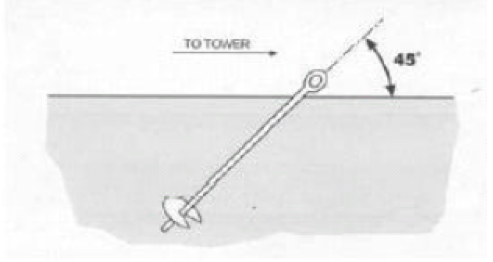
Drive-In Anchors
Drive-in anchors are recommended for denser, rocky soils, Classes 2-5 in Table 1. A drive-rod is used to drive the anchor into the ground. Drive rods can be driven manually with a sledge or with power equipment if available. The drive-in anchor must be “set” by pulling the anchor until it rotates 90°. We recommend proof testing each anchor with a dynamometer to ensure that it is properly installed.
These anchors are useful in denser soils because they can be forced into the soil more easily, and the triangle design tends to thread around rocks in the soil.
Rock Anchors
Rock anchors are standard in the construction industry for rocky areas. They are appropriate for soil Classes 0-1 in Table 1. They require drilling a hole for insertion of a threaded rock anchor. The anchor can then be cemented into place if desired. Grouting is necessary with soft, crumbling rocks or if weathering is expected.
The anchor is then dropped into the hole, and the eye is threaded with a bar and rotated until the anchor has expanded firmly against the sides of the hole. The anchor should be installed at a specific depth into solid rock.
Concrete Block
As a general rule, unless the details of the dam bed, water depth, PH level, tailings depth and density is known and appropriate design and preparations are made, concrete blocks / round barrels as individual anchors are not supported by Xrosswater Ltd. Past events at locations where other floating structure have been installed and in which concrete blocks were used as the sole anchoring solution, incurred problems such as the blocks sliding on hard rock surfaces, rolling, corrosion of eye loops, difficult to install, blocks not heavy enough, cost of production, cost of handling, blocks moving towards penstock etc.
Xrosswater Ltd may select the use of concrete block in certain design conditions where guidance, ballast or a web of chains and weights are required.
Lined Dams & walkway stability
More mines are required to line the dams to prevent water leakage. In this circumstance it is required that the anchors are installed before the dam in lined so that the lining can be sealed around the anchor shaft. Second sheets of lining can be installed to prevent wear where necessary. On existing lined dams, depending upon the topographic design of the dam, water level etc, cables can be anchored to the top rim of the dam and with the use of ballast weights and floatation balls, the cables can be kept under tension ensuring the Xrosswater Walkway will remain in position as desired. Further ballast and drogues can be inserted or attached to the walkways and anchor cables to increase walkway stability.
Anchor Guidelines
The anchors used with the Xrosswater system are critical components to the Xrosswater installation that when managed correctly will ensure long lasting problem free use of the walkway.
Soil Type
The following information is provided as an aid in determining the proper anchors and installation methods. However, all sites are different and correct site assessment and soil / tailings determinations is required to determine what type and what quantity of anchors are required.
Settling Density
Most Tailings deposit settle differently. It is important to determine what is the normal percentage of water to tailings that is deposited and at what rate the tailings deposit settles and if the settled tailing has any compounding characteristics that would support and increase the holding load of the anchor. This information is significant depending upon the required load the anchors will be required to sustain and the desired lifespan of the platform or walkway.
Depth of Tailings
With the soil type and anchor type selected, determination of what is the appropriate depth below the surface at which an anchor can obtain a respectable hold is required. This information can be obtained through proof testing at numerous locations along the proposed walkway position.
Weather conditions
In addition to the soil type and depth it is also important to know the weather conditions at the site, such as maximum winds, directions and icing that may collect on the water. Soil conditions can soften or change markedly with heavy rains. Since there can be variations in the precise soil condition at a site, you may want to purchase two or more types of anchor sizes for the installation, and choose the appropriate anchor once you have begun installation.
PH Levels
Understanding the present or the future PH level of the water is required to ensure that the correct chain type and linkage pieces are selected. Should there be a long distant between the anchor and the walkway, in certain circumstances wire rope can be utilised and even at times certain fibre ropes can suffice.
Types of Soil
Soil Classification & Description
Class 0: Unweathered sound hard rock. Includes granite, basalt, massive, limestone.
Class 1: Very dense and/or cemented sands; coarse gravel and cobbles. Includes caliche (nitrate-bearing gravel/ rock).
Class 2: Dense fine sand; very hard silts and clays (may be preloaded). Includes basal till, boulder clay, caliche, weathered laminated rock.
Class 3: Dense sands and gravel; hard silts and clays. Includes glacial till, weathered shales, schist, neiss, and siltstone.
Class 4: Medium dense sand and gravel; very stiff to hard silts and clays. Includes glacial till, hardpan, marls.
Class 5: Medium dense coarse sand and sandy gravel; stiff to very stiff clays and silts. Includes saprolites, residual soils.
Class 6: Loose to medium dense, fine to coarse sand; stiff clays and silts. Includes dense hydraulic fill, compacted fill, residual soils.
Class 7: Loose fine sand; alluvium; loess; medium stiff and varied clays; fill. Includes flooded plain soils, lake clays, adobe, gumbo, fill.
Class 8: Peat and organic silts; inundated silts, fly ash, very loose sands, and very soft to soft clays.
Includes miscellaneous fill, swamp marsh.
Deck Anchor Management techniques
1) 2nd strop to prevent loss of chain
On the deck of the Xrosswater walkway there is a stainless steel eye to which the anchor chains are shackled to. Previous experience has illustrated that when anchor chains are being adjusted occasionally the fitters can accidentally drop the anchor chain into the tailings. The 2nd stop is a preventative measure to ensure that the chain is always connected.
2) Rubber elastic tensioner
Where dam water level fluctuates regularly, the integration of elastic tensioners will ensure the walkway anchors or guy ropes are always under tension which eliminates the need for the anchor chains to be manually tightened or slackened.
3) Extended crossmembers
The normal width of the Xrosswater walkway is 1.5m wide. By increasing the width of the walkway from an anchoring perspective we also increase the stability of the Xrosswater walkway. By extending the crossmember at the point where the anchors are located by 0.75m on both sides, the width of the walkway will be 3m. The anchor chain would attach to the stainless steel eye, travel horizontally through a fairlead, then diagonally into the water, through the tailings and to the dam bed where it connects to the anchor.
4) Anchor load Indicators
The “Xrosswater Anchor Load Indicators”. Designed and produced in bright orange to act as a visual indicator to the operators of the load that the anchor chains or cable are enduring. Once the load on any of the anchors chains has exceeded a pre-determined level, the load indicator will detach and clearly indicate to the user that adjustments are necessary. Once the separation has occurred, the load on the chain is transferred back to the chain allowing a number of days for the necessary adjustment to be completed.
The benefit of utilising the “Xrosswater Anchor Load Indicators”, is that the operator is able to keep records of which anchor has been adjusted and which hasn’t, and through this, they would be able to pin point which anchor is potentially slipping and not secure.
